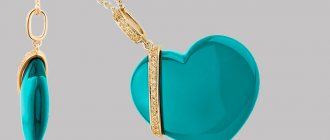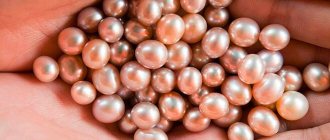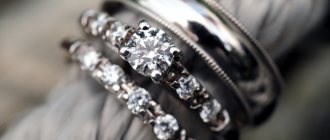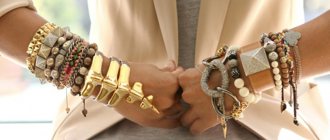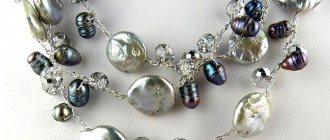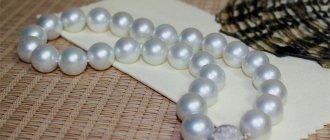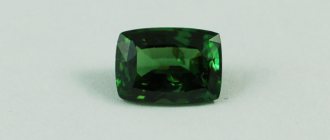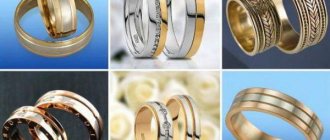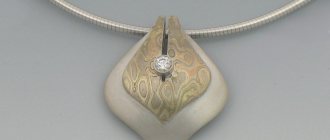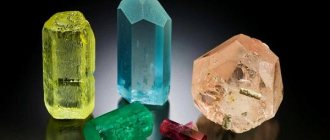Nuances and differences between different types of neck jewelry: from chokers and necklaces to chokers and collars. Features and assistance in choosing products.
There are many more types of neck jewelry than just the popular necklaces, chains and beads.
Each type of product has its own characteristics, its own aesthetics, and its own interesting history. To begin with, we note that both a necklace and a necklace are necklaces that usually have a clasp. Such jewelry has been known since ancient times - one only has to remember the images of the ancient Egyptians with many different pendants, earrings, and bracelets. However, neck decorations made of bones, stones (and not only precious ones) were known back in the Stone Age. At all times, people have strived to look more beautiful, and this could easily be achieved with the help of jewelry. Nowadays, jewelry like a necklace or necklace is worn mainly by women. However, in different cultures at different periods of history, men also wore them.
Initially, the decoration on the neck was denoted by the word “necklace”, which comes from the Old Slavonic “gerlo” - throat. The word "necklace" is of French origin and translated means "collar". Usually the word “necklace” refers to a broader concept, that is, any neck decoration. The word “necklace” has a narrower meaning.
Definitions
Necklace
A necklace is a neck decoration with a pronounced central part in the form of one or more decorative elements. It is a sophisticated product intended exclusively for women. The history of the necklace goes back to ancient times. Thus, in the Stone Age, people hung peculiar jewelry around their necks from the fangs and claws of animals killed while hunting. The term “necklace” itself appeared in Russia only in the 18th century and was considered synonymous with a necklace. At that time, items with diamond pendants in the form of a drop or an asterisk were especially popular. The decoration was considered ceremonial and was worn at balls and social evenings. In the 1880s, necklaces began to be complemented by brooches and earrings made in the same style. And in the 20th century, products inlaid with semi-precious stones with a pendant in the form of a horseshoe or an Easter egg came into fashion.
Necklace
A necklace is a neck decoration made of precious stones, pearls, beads, coins and other materials. The prototype of this product appeared before our era. The word itself comes from the Old Russian “zherelo”, which can be translated as “throat”. In Rus' in the 11th century, decorations in the form of collars, embroidered with gold and decorated with precious stones, were widely popular. This product was worn only with outerwear and fastened to a fur coat or caftan. It is worth noting that until the 19th century, necklaces were not particularly relevant due to the dominance of lush frills, bows, ruffles and frills in world fashion. Today, the latest technologies and high-quality materials are used to make jewelry. The most widespread at the moment are necklaces made of gold and silver, complemented with topazes, sapphires, and emeralds. However, handmade products made from beads and bugles also look very stylish and cute.
What to wear this season?
The favorites of the current season are heavy, massive beads and wide necklaces. They can consist of either metal with inlays and elaborate treasure decorations, or natural large stones of various shapes.
The trend of the year is multi-layered decoration. Multi-row necklaces and choker necklaces will be trendy. With leather inserts made of reptile scales, lace - they do not go out of fashion and look graceful and elegant.
Handmade necklaces in ethnic Victorian style are another major current trend. Huge necklaces and beads with eye-catching beads, knitting elements, and large flowers are relevant at any time. Necklaces in the form of a shirtfront or collar look impressive; they are fully suitable for a strict business style.
Irregular, rough forms of stone that look untreated are considered relevant. The combination of different color combinations in one decoration is relevant.
Comparison
In fact, the two jewelry we are interested in have a lot of similar features and a minimal amount of differences. We will dwell on the latter in more detail. As can be seen from the definition, a necklace is a neck decoration with a pronounced central link. All decorative elements in it are concentrated in the front part, while at the back there is often only a chain or hoop. A necklace is an expensive, highly artistic piece of jewelry made using precious and semi-precious stones. In most cases, it is made of precious metals and is worn for important events along with an evening outfit.
The main difference between a necklace and a necklace is that the latter decoration is evenly distributed along its entire length. That is, it does not have a clearly defined central part, and all elements are equal or close to each other in size. A necklace is not always an expensive item made with precious stones. It can be made from pearls, beads, glass beads, fabric, shells and other available materials. Many needlewomen create jewelry with their own hands at home. Such products are quite suitable for everyday wear; they can be combined with almost any thing.
To summarize, what is the difference between a choker and a necklace.
Types of neck jewelry
Both necklaces and necklaces can differ in length, which allows you to divide neck jewelry into the following types:
- A collar is a decoration that is 30-35 cm long and is worn directly on the neck so that it fits tightly.
- Choker is a freer decoration. It is 35-40 cm long. As a rule, it lies above the collarbone.
- Princess - a version of the neck decoration with a length of 43-48 cm.
- Matinee (“matinee” translates as “morning”) - their length reaches 50-60 cm.
- Opera - jewelry 66-91 cm long.
- Rope (from the English "rope" - rope) and lariat ("lariat" - lasso) differ from each other only in that the "lariat" is an ornament whose ends are not connected. They are usually decorated with tassels. The length of decorations of the “rope” and “lariat” types reaches 120-180 cm.
History of decoration. Necklace
"Collier" comes from the French "collier" and means "collar" or "necklace". The history of the appearance of necklaces as jewelry goes back centuries. The necklace is considered one of the oldest jewelry, since the most ancient finds of jewelry in archeology are beads - that is, beads strung on a thread. Bright pebbles, animal bones and horns, seeds or nuts became beads. Thousands of years ago, Stone Age people created their jewelry from wooden sticks, bones, and smooth shells.
Alanya Antiquities Museum "Iudzinad".
Later in the Iron Age, jewelry began to be made from metal.
These decorations were found on the territory of the modern northern Caucasus and are stored in the Museum of Antiquities of Alanya “Iudzinad”.
For the inhabitants of Mesopotamia, the necklace was an integral part of the outfit; even common people could afford it, although they had access to jewelry made from the cheapest materials. The jewelry of Ancient Sumer was revealed to the world by archaeologist Leonard Woolley during excavations of the Sumerian city of Ur in the 20s of the 20th century. He discovered the tomb of Queen Pu-Abi (Shubad), which is 4.5 thousand years old. Now it is impossible to say with certainty who this woman was, buried with such honors. Queen, priestess or incarnation of the goddess Inanna? One of the Sumerian myths, “Inanna's Descent into the Underworld,” says that the goddess was supposed to descend to the kingdom of her sister Ereshkigal, the goddess of the dead. Inanna had to go through 7 gates, each time removing parts of her royal robe and jewelry. Having passed the last, 7th gate, she found herself completely naked and helpless, like an ordinary mortal, and Ereshkigal turns her into a corpse. When Inanna died, life stopped on earth, birth stopped, love ceased, and the gods began to take measures to bring Inanna back. On the way back, having returned her jewels, Inanna regains her power. This fragment of the myth shows that there is much more meaning and meaning hidden in the jewelry of the Sumerian priestess Pu-Abi than we used to think.
Pu-Abi was found all strewn with precious jewelry - gold, silver, lapis lazuli, carnelian, agate and chalcedony beads, with large gold earrings and a headdress of gold flowers inlaid with Indian carnelian and Afghan lapis lazuli. Also noteworthy is the large number of carnelian beads. According to one version, lapis lazuli was considered a male stone in Mesopotamia, and carnelian was a female stone, so it is quite logical that they form the basis of Pu-Abi’s costume. The costume of the priestess of the most ancient female deity certainly has a hidden sacred meaning and contains a lot of symbolism that is not fully understood.
Ancient Egypt
In Ancient Egypt, the necklace was given the appearance of a wide plate or flat sphere with inserts of gems and religious symbols. Ancient Egyptian craftsmen mastered many techniques for making jewelry from a variety of materials. Most often, jewelry in Ancient Egypt was created on the basis of gold, of which there was no shortage. With the help of special additives, jewelers could change its color in a wide range from light to green. Gold was valued primarily for its picturesque appearance rather than for its cost. For example, iron was a much rarer and more valuable metal. The Egyptians did not yet know precious stones such as rubies or emeralds; instead they used ornamental stones: amethyst, carnelian, garnet, as well as lapis lazuli, which was especially highly valued. Rock crystal was loved in Egypt. For the poor, it was replaced by transparent or colored glass and small beads, which served as the basis for many bracelets and necklaces. Ordinary people also used ceramics covered with multi-colored patterns. The Egyptians loved bright and saturated colors, so jewelers often used techniques such as smalt and enamel in their work. Bright, multi-colored pastes were popular for coating materials for decoration. Apparently, the favorite colors in Ancient Egypt were turquoise, green, white and blue. Probably, such shades looked quite impressive on dark skin. The Egyptians knew almost all types of jewelry that are still used today. The most popular accessory was perhaps necklaces, worn by both women and men. They were made from gold plates, beads or pendants of various shapes. The traditional decoration of Ancient Egypt was the uskh, the so-called sun necklace, which was attached to a leather lining and resembled a collar. The pharaoh's uskh could weigh several kilograms; this item was often used as a reward for distinguished commanders and officials.
It is no secret that the Greeks were keen connoisseurs of beauty and aesthetics. The ancient Greeks loved elegant jewelry, simple and harmonious, but they did not welcome excesses.
People in ancient Greece were characterized by a passion for jewelry, but abusing them in everyday life was considered bad manners and was condemned by society. Times changed and attitudes towards jewelry also changed; strict laws began to be neglected. Gold jewelry that was worn around the neck was in great demand - necklaces, pendants, chains... For these decorations, wavy plant patterns using vine leaves, flowers, and buds were also often used.
Neck decorations were sometimes assembled from individual elements, soldering them to each other, or connecting them mechanically. In jewelry technology, the method of diffuse soldering was very common, with the help of which point grains were obtained. Necklaces and wreaths had a variety of pendants in the form of fruits, flowers, dolphins and other animals. In the Middle Ages, the necklace became a luxury item and was characteristic of the royal nobility. Jewelry was also a symbol of power. This is evidenced by the fact that in the 13th century a law was passed according to which commoners were forbidden to wear gold, silver, pearls and precious stones. After the French Revolution, jewelry ceased to be the privilege of the nobility, and was increasingly worn by the bourgeoisie. In the 19th century, they became a favorite way of investing, and are still popular today. At all times, a necklace has adorned a woman, emphasizing her beauty or status. To write this publication, freely available materials were used.
Types of necklaces and necklaces
These two names for neck jewelry - choker and necklace - are often confused. So first, let's understand the terms. If we turn to the origin of these words, we will find the reason for the confusion in the names. The fact is that the word “necklace” basically means the same thing as the word “necklace”. The word “necklace” comes from the Old Slavonic “gerlo”, which meant the front of the neck - “throat”. That is, in the literal sense, the “necklace” is what is around the throat. In Ancient Rus', a necklace was a collar and collar of chain mail, as well as the neck of a cow or bull. And later this word began to be used to describe various jewelry that was worn around the neck. The word “necklace” - (English collier) came to us from France and translated means “collar” or “worn around the neck.” Today the word "necklace" in Russian is used to name a certain type of neck decoration.
What do the beads look like?
This product is made of beads without a frame, which are strung on one or several threads. Beads come in different types: long and short, with different or identical beads in color, shape, and size. They are strung on one or more threads, made with or without a lock.
This can be either an adornment for everyday wear in the form of regular jewelry, or a piece for an evening out, because they are made from a variety of materials: from simple plastic or wood to expensive pearls with gold or silver fittings.
Slavage necklace
Slavage is a ribbon-shaped strip that fits tightly around the neck and is decorated with precious and semi-precious stones. The sklavage has a pendant that fits into the dimple of the neck. The name of this jewelry comes from the French word “esclavage”, which translated into Russian means “slave collar”. The main part of the necklace can be made of either fabric or a large number of chains.
Slavage became widespread at the end of the 18th century; it was worn with fairly revealing outfits. Pendants for sklavage were made in the form of crosses, bows, Easter eggs and bright pearl threads. By the way, during the Renaissance, such jewelry was worn not only by women, but also by men. Among the representatives of the stronger half of humanity, sklavages with a pendant in the form of a medallion were popular.
Today, many European Fashion Houses offer exclusive and spectacular clavas in their jewelry collections. They are decorated with precious stones - diamonds, sapphires, emeralds and rubies. Stylists recommend wearing this kind of jewelry in combination with evening dresses.
Types of necklaces and necklaces by appearance
Based on their appearance, these decorations are divided into many types. The most common types of necklaces are: riviera, clasp, slavage, plastron.
Riviera collier (necklace) is a type of necklace in which identical or homogeneous stones are connected in such a way that you cannot see the fastening points, which creates the illusion of a flowing river stream. This exceptionally beautiful decoration is appropriate only with an evening outfit.
Clasp (English fermoir, clasp collier, necklace) is a necklace in which the clasp is located in front and is the central part of the decoration. The name comes from the French fermoir - fastener.
Slavage (eng. esclavage collier, necklace). The term comes from the French esclavage - slavery. A slavage necklace consists of chains that form a strip into which inserts of precious stones or beads are attached. A slavage necklace consists of a strip of fabric on which precious stones are attached. The strip with stones clasps the neck quite tightly, and a beautiful pendant falls into the hollow.

